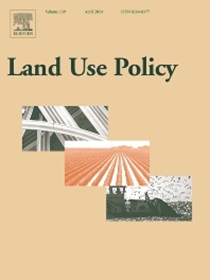Embedding (Semi-) automatic cadastral boundary extraction into fit-for-purpose land administration in peri-urban ethiopia
IF 6
1区 社会学
Q1 ENVIRONMENTAL STUDIES
引用次数: 0
Abstract
The creation and upkeep of cadastral data is essential for maintaining land and resources and advancing sustainable development. However, developing nations face land use challenges in peri-urban areas due to the fast-paced increase in population and rapid urbanization. Moreover, conventional cadastral surveying methods are neither time nor cost-effective. Automatic feature extraction (AFE) is an emerging alternative to conventional field surveying methods, which can help land sector professionals adhere to the principles of fit-for-purpose land administration (FFPLA). The study aims to test and subsequently affirm the potential of the AFE approach using open-source tools for cadastral mapping in peri-urban areas. It adopts a generalized pre-exiting AFE workflow, utilizing free and open-source tools for the complete solution, including image segmentation, boundary classification, interactive delineation, and validation. High-resolution satellite images and a reference cadastral dataset are used for the pilot. The case location is a peri-urban area in Dukem, with source material obtained from the United States Agency for International Development (USAID) Land Governance Activity (LGA) Ethiopia branch. The LGA experts actively participated in the pilot testing through demonstrations, hands-on practice, focus group discussions, and questionnaire data collection. The pilot testing demonstrate that interactively delineated cadastral parcel boundaries delivered 66 % correctness for buffer widths of 0.5 and 0.4 m for the reference and interactively extracted boundary lines, respectively. The implemented AFE approach was further evaluated against the FFPLA elements and found to meet the affordability, attainability, flexibility, and upgradeability requirements. The strengths, weaknesses, opportunities, and threats (SWOT) analysis indicated favorable strengths and opportunities with manageable weaknesses and threats. The approach is supposed to be applicable for cadastral mapping and updating in peri-urban areas and newly emerging towns across the country due to rapid urbanization. Nonetheless, comparisons against conventional non-AFE methods, such as GNSS or total station surveys, in terms of time and cost implications are still needed. Moreover, further enhancement and testing with different land administration settings are recommended to apply the approach to real-world scenarios such as the LGA cadastral mapping project.
求助全文
约1分钟内获得全文
求助全文
来源期刊

Land Use Policy
ENVIRONMENTAL STUDIES-
CiteScore
13.70
自引率
8.50%
发文量
553
期刊介绍:
Land Use Policy is an international and interdisciplinary journal concerned with the social, economic, political, legal, physical and planning aspects of urban and rural land use.
Land Use Policy examines issues in geography, agriculture, forestry, irrigation, environmental conservation, housing, urban development and transport in both developed and developing countries through major refereed articles and shorter viewpoint pieces.
 求助内容:
求助内容: 应助结果提醒方式:
应助结果提醒方式:


